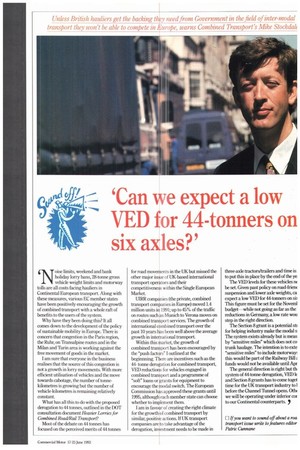P 'Can we expect a low
Page 45

If you've noticed an error in this article please click here to report it so we can fix it.
VED for 44-tonners on six axles?'
,N oise limits, weekend and bank holiday lorry bans, 28-tonne gross
vehicle weight limits and motorway tolls are all cost facing hauliers in Continental European transport Along with these measures, various EC member states have been positively encouraging the growth of combined transport with a whole raft of benefits to the users of the system.
Why have they been doing this? It all comes down to the development of the policy of sustainable mobility in Europe. There is concern that congestion in the Paris region, the Ruhr, on Transalpine routes and in the Milan and Turin area is working against the free movement of goods in the market.
I am sure that everyone in the business realises that the source of this congestion is not a growth in lorry movements. With more efficient utilisation of vehicles and the move towards cabotage., the number of tonnekilometres is growing but the number of vehicle-kilometres is remaining relatively constant.
What has all this to do with the proposed derogation to 44 tonnes, outlined in the DOT consultation document Heavier Lorries for Combined Road/Rail Transport?
Most of the debate on 44 tonnes has focused on the perceived merits of 44 tonnes
for mad movement in the UK but missed the other major issue of UK-based international transport operators and their competitiveness within the Single European Market UIRR companies (the private, combined transport companies in Europe) moved 1.4 million units in 1991; up to45% of the traffic on routes such as Munich to Verona moves on combined transport services. The growth of international combined transport over the past 10 years has been well above the average growth in internat tonal transport Within this market, the growth of combined transport has been encouraged by the "push factors" I outlined at the beginnning. There are incentives such as the 44tonne derogation for combined transport. VED reductions for vehicles engaged in combined transport and a programme of "soft" loans or grants for equipment to encourage the modal switch. The European Commission has approved these grants until 1995, although each member state can choose whether to implement therm
lam in favour of a-eating the right climate for the growth of combined transport by similar, positive actions, If UK transport companies are to take advantage of the derogation, investment needs to be made in
three-axle tractors/trailers and time is to put this in place by the erid of the ye The VED levels for these vehicles rx be set. Given past policy on mad-frier suspension and lower axle weights, ca expect a low VED for 44-tormers on sb This figure must be set for the Noveml budget while not going as far as the reductions in Germany, a low rate won step in the right direction.
The Section 8 grant is a Potential sn for helping industry make the modal s The system exists already but is mean by "sensitive miles" which does not on trunk haulage. The intention is to exte "sensitive miles" to include motorway: this would be part of the Railway Bill funds would not be available until Apr The general direction is right but th system of 44-tonne derogation, VED k and Section 8 grants has to come toget time for the UK transport industry to I before the Channel Tunnel opens. Othi we will be operating under interior ox to our Continent! counterparts.
1-1 If you want to sound off about a roa transport issue write to ftatures editor Patric Cunnane
















































































